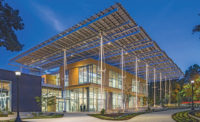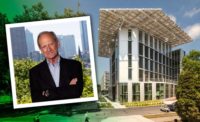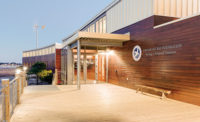Super-Sustainable Bullitt Center is ENR Editors' Choice for Best Project in 2013














During a 2010 preconstruction meeting with the owner-developer of Seattle's super-sustainable Bullitt Center, the 50,000-sq-ft project's consulting engineer had a minor meltdown over electric-plug loads—the silent killer of green-building power conservation. Paul Schwer's eventual victory over his plug-load agita exemplifies the way the job's team members often were forced to exit their comfort zones during the $30-million project. In doing so, they not only improved Bullitt Center, they created an example for others to follow.
"Once someone demonstrates something is possible, others can do it," says Denis Hayes, president of the Bullitt Foundation since 1992 and the catalyst for the multi-tenant, self-sustaining building. In 1970, Hayes, then 25, coordinated the first Earth Day, which triggered the nation's environmental movement. Still, he calls Bullitt Center the realization of a dream "to do something exceptional."
Bullitt Center is built to satisfy its own energy, water and waste needs in a revenue-producing environment. The center also serves as Bullitt's living laboratory to further the foundation's mission of elevating environmental awareness.
Hayes had triggered Schwer's plug-load worries by suggesting Schwer's Portland, Ore.-based firm, PAE Consulting Engineers Inc., open up a Seattle office in Bullitt Center. Plug loads were an issue for the president of the 100-person mechanical-electrical-plumbing engineer because the year-old building is on course to become the nation's first urban mid-rise speculative development to be certified under the Living Building Challenge. Developed by the International Living Future Institute (ILFI), LBC is a demanding program for self-sustaining buildings—it makes attempting even the top level of the LEED green-building rating system look like child's play.
Among many things, LBC certification is predicated on annual net-zero energy use, which means all power used in a year does not exceed the power produced by the rooftop solar photovoltaic array. LBC tenants must commit, in their leases, to very low plug loads, which typically are unrestricted and account for half of all the power used in an office building.
Engineers' plug loads are usually higher than average, thanks to their use of power-drawing high-end computers for analysis. Schwer knew PAE could not meet Bullitt's plug-load diet. "I had a sinking feeling because I knew we couldn't even move into this building we were designing," says Schwer.
But the engineer didn't want to disappoint Hayes, so he found a plug-load-reduction solution that not only allowed PAE to move in but also serves as a model for any business. "If we engineers can do it, any other firm can do it," says Schwer.
PAE slashed Bullitt Center plug loads by buying more energy-efficient computers, including light-emitting-diode monitors, laptops and a centralized server instead of desktop computers. Housed in a dedicated room, the server offers the same speed as desktops, uses less power and makes heat recovery possible, says Schwer. He then decided to switch to the more efficient computer technology in PAE's Portland and San Francisco offices, as well.
Bullitt Center has all the bells and whistles of sustainability. Its 14,303-sq-ft rooftop PV system has the capacity to generate 16,000 Btu per sq ft per year—the same figure as the energy-use target. A typical Seattle office building uses 70,000 Btu per sq ft per year, according to Bullitt.
Rainwater is harvested and stored in a 56,000-gallon basement cistern. Waste management is on-site. The building is naturally ventilated and 82% naturally lit. A geothermal heating and cooling system has twenty-six 400-ft-deep wells. Steel and concrete originated within a 300-mile radius and wood within a 600-mile radius. Built with non-toxic products and materials, the center is built to last 250 years.
For Hayes, the project's success revolved around team-wide collaboration, cooperation and coordination. In June 2009, to set the stage, he held a two-day workshop for about 40 leaders of the building team. LBC's founder, Jason McLennan, International Living Future Institute president and CEO, attended to present the LBC philosophy.
A year's worth of weekly preconstruction meetings followed, and construction started in August 2011.














